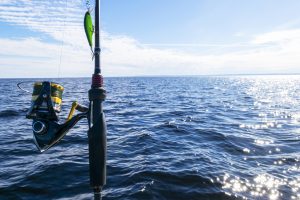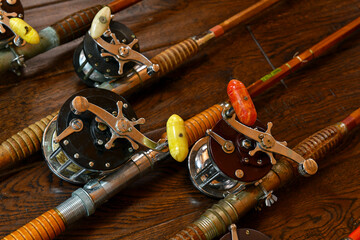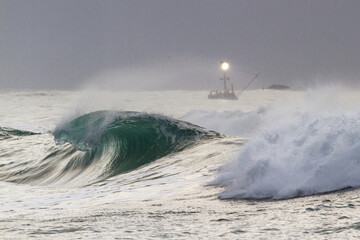Wondering how to cast a conventional reel? This article will help you. The art of fishing includes a wide variety of modalities that have been with us for several centuries and in which it is not only necessary to know how to fish.
One of the modalities of sport fishing, specifically deep-sea fishing, most practiced by sea fishermen is curry fishing, caeca, or in English, Conventional reel.
A conventional reel is based on throwing the fishing line into the water from a boat that drags the gear behind it. This modality is not only carried out in the sea but can also be done in river waters, reservoirs, lakes, or wide rivers.
What Types Of Conventional Reels Exist?
The conventional reel modality has possible alternatives: the conventional reel on the surface, mid-bottom, or at great depths. Different species can be caught depending on the depth at which this type of sport fishing is carried out.
Conventional reel at great depths is usually done for more commercial purposes, while if we do it on the surface or a few meters from it, a conventional reel is more sporting and recreational.
Do conventional reels cast farther?
Below are the classification of conventional reel casting and how far they can go:
Surface conventional reel
This modality is practiced at a maximum distance of 12 miles from the coast. This type of fishing is also called coastal conventional reel, where the most common catches are medium or small in size.
This usually depends on the fishing area, although in general, the fish that inhabit the areas near the coast looking for food are medium-sized. Another determining factor to carry out a conventional reel on the surface is the bait.
In this modality, more catches are usually attracted with the use of natural baits, although glider-type lures are also useful for a conventional reel.
Sea bream, amberjack, frigate tuna, pomfret, and lily are the species of fish that we will fish the most near the coast.
5 unique benefits of using red hooks for fishing
Bottom conventional reel
As mentioned above, this fishing specialty is usually carried out for a more commercial purpose. Although there are also sport fishermen who like to carry out the curry at relatively greater depths, from 10 to even 50 meters deep.
In the bottom conventional reel, we can obtain large and heavy catches such as sea breams, mojarras, and snappers.
Another very important aspect is the use of the right fishing leads to gain access to the required depths. Down riggers can also be used, both electric and manual, to get our gear much more precisely to the depths of the sea.
Equipment For Conventional Reel
It is useless to use ultra-powerful fishing equipment and equipment when you are going to fish a few meters from the surface where the potential catches will be small and the demand that they will give to the equipment will be minimal. For this reason, fishing equipment must be used according to the type of fish species that you are looking for.
Conventional reel line and thread
To carry out the bottom conventional reel, the line must be thick and very resistant. A great option would be the choice of a braided thread to gain greater resistance.
Conventional reel rods
Ideally, the resistance of these rods should range between 12 and 30 pounds maximum. Employ the use of light fishing rods for surface fishing, with roller rings if possible. You can detect the bite quickly and be able to keep an eye on the collection of the line as soon as possible.
To fish thoroughly you will have to give a little more power and resistance as well as length to be able to sustain the large prey with which you will have to battle when pulling.
Lures for conventional reel
 Commonly called Conventional reel exciters are used as lures. These are artificial baits with a lot of colors and are very showy.
Commonly called Conventional reel exciters are used as lures. These are artificial baits with a lot of colors and are very showy.
They are usually accompanied by feathers that serve to draw the attention of predatory fish as much as possible since these lures imitate the predators’ prey when swimming. Besides, a large number of fishermen prefer natural baits due to the smell they give off.
It is convenient to adapt your lures depending on the type of conventional reel that you are going to do since the inappropriate use of these gear will result in either the loss of catches or breakage of the material.
Mostly we can distinguish two types of lures:
- Hooks with natural baits
- Artificial baits or lures
You can use triple or jigger fishing hooks for those fans who choose natural bait since in this way the bait will hold more firmly to your hook and there will be no problem of losing it along the way.
As for the use of artificial lures, there are many options, from vinyl octopuses with very bright colors to exciters with feathers to attract the attention of predators to lure different types of fish.
How Do You Cast A Conventional Reel On A Boat?
A very effective type of conventional reel is vinyl octopus lures with raffia. To opt for different species that live at different depths, you can use various types of length and depth in your fishing lines.
Depending on the type of catch you want to catch, you must adapt the speed of your boat, up to 7 knots for tuna fishing, no more than 3 knots for horse mackerel fishing. You should also take into consideration the meters of distance between the lure and the boat.
There are some species such as sea bass, for example, which are more skittish and sting at about 100 meters away, while some tuna bite at just 10 meters. Moreover, you have to practice a lot, especially if you fish deep or medium-deep, to know with certainty at what depths our lure navigates.
In addition, the use of gliders will make the bait go down to the bottom at high speed. You should also know that users who carry out conventional reels do not usually navigate at more than 4 knots and the recommended distances from the boat to the lure range between 10 and 500 meters.
How To Stop Backlash On A Conventional Reel?
Backlash can be extremely annoying especially when it occurs suddenly. When your lure slows during or after casting and the spool continues to spin. Usually, this results in a tangled, messy, and frustrating line.
One main cause is fishing in the wind. To overcome a backlash, it is best to make your cast across or in synchronization with the wind. If you choose to cast into the wind, you should move closer to the water and make short and low pitches.





